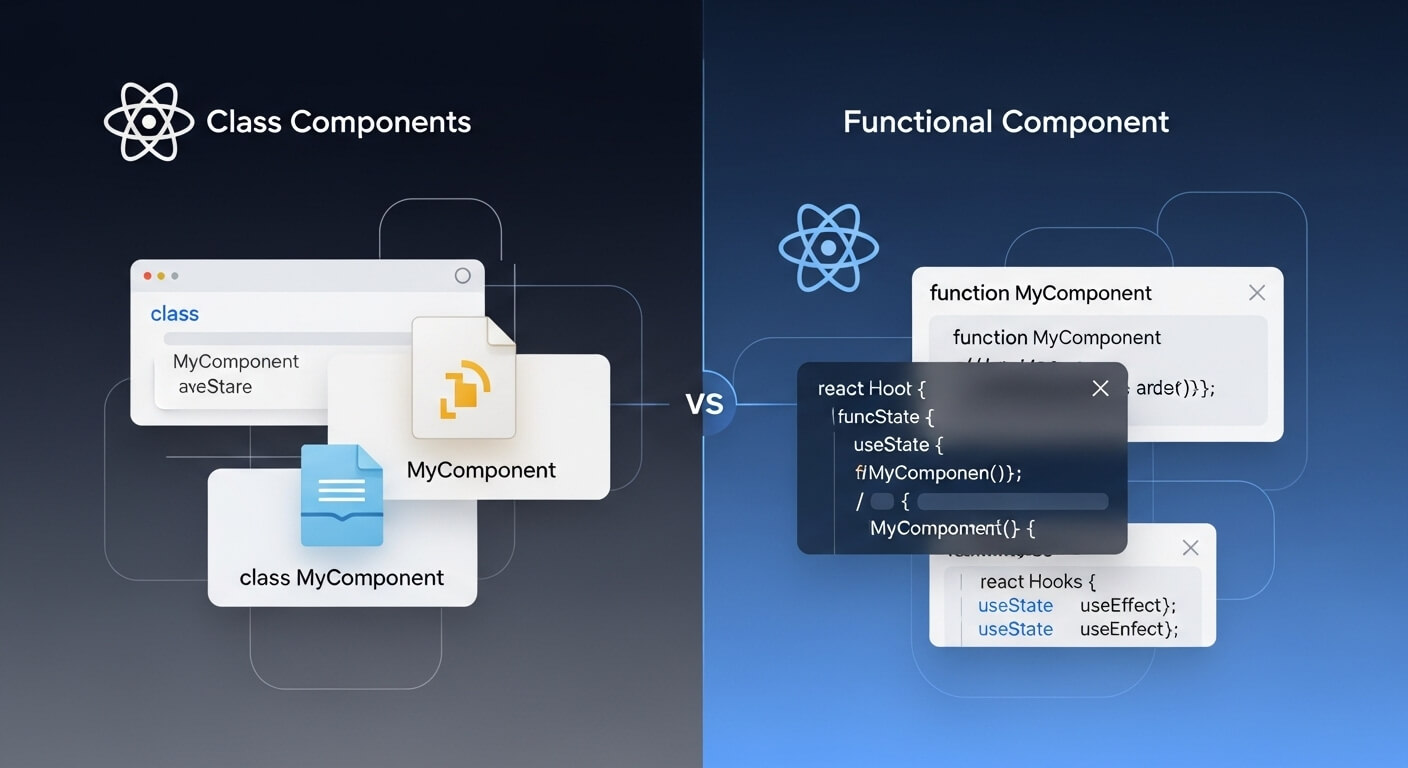Understanding the difference between class and functional components in React is crucial for building modern, efficient applications. In this article, we’ll walk through difference between class and functional components step by step, covering syntax, performance, state management, lifecycle methods, and best practices.
Learn more about: higher order components react
What Is the Difference Between Class and Functional Components?
When comparing the difference between class and functional components, the primary distinction lies in syntax and capabilities:
- Class Components are ES6 classes extending
React.Component. - Functional Components are JavaScript functions that return JSX.
The difference between class and functional components becomes more apparent when you introduce state and lifecycle methods. Class components relied on methods like componentDidMount, whereas functional components leverage Hooks such as useEffect and useState to handle side effects and state – a modern shift highlighted in the official React docs .
Syntax Comparison
// Class Component
class MyComponent extends React.Component {
constructor(props) {
super(props);
this.state = { count: 0 };
}
componentDidMount() {
console.log('Mounted');
}
render() {
return <div>{this.state.count}</div>;
}
}
// Functional Component with Hooks
function MyComponent() {
const [count, setCount] = React.useState(0);
React.useEffect(() => {
console.log('Mounted');
}, []);
return <div>{count}</div>;
}The above example clearly shows the difference between class and functional components: functional components are shorter, more readable, and avoid the this keyword.
Performance Benefits
One of the most compelling difference between class and functional components is performance:
- Functional components tend to have smaller bundle sizes.
- React’s internal optimizations (like PureComponent) can be more effectively applied to functional components with
React.memo.
By choosing functional components, you can reduce overhead and improve rendering speed by taking advantage of memoization and avoiding unnecessary lifecycle method overhead .
State Management and Hooks
The introduction of Hooks eliminated most reasons to use class components. With Hooks, you can:
- useState: Manage local component state.
- useEffect: Handle side effects.
- useContext: Share global data.
- useReducer: Manage complex state logic.
This evolution dramatically changes the difference between class and functional components, making functional components the default choice for new React codebases.
Lifecycle Methods vs. useEffect
Class components rely on methods such as:
componentDidMountcomponentDidUpdatecomponentWillUnmount
Functional components combine these into a single useEffect Hook:
useEffect(() => {
// Code to run on mount
return () => {
// Cleanup on unmount
};
}, [dependencies]);This consolidation simplifies the difference between class and functional components, reducing boilerplate and potential bugs.
Readability and Testing
Functional components promote cleaner code:
- Smaller functions are easier to test.
- No need to bind methods or deal with
this. - Encourages modularity by splitting logic into custom Hooks.
These improvements highlight the evolving difference between class and functional components, favoring functional approaches for maintainability.
When to Use Class Components
Although functional components are generally preferred, class components may still be used when:
- Legacy Codebases: Large existing codebases still using classes.
- Error Boundaries: Currently, only class components can implement
componentDidCatch.
However, most modern React projects are migrating away from classes, shrinking the practical difference between class and functional components.
Migrating Class to Functional
To convert a class component:
- Replace
classdeclaration with a function. - Swap
this.stateandthis.setStatewithuseState. - Merge lifecycle methods into
useEffect.
By following these steps, you can bridge the difference between class and functional components seamlessly.
External Resources
- Official React Components & Props documentation: https://react.dev/learn/passing-props-to-a-component
- React Hooks introduction: https://react.dev/reference/react/hooks
- Advanced Hooks: https://react.dev/reference/react
By focusing on the difference between class and functional components, you can make informed decisions when architecting React applications. Embrace functional components for cleaner, faster, and more maintainable code—while understanding when class components still have a place.


Leave a Reply